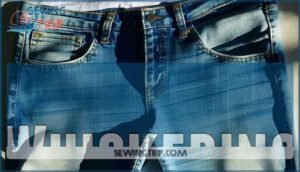This site is supported by our readers. We may earn a commission, at no cost to you, if you purchase through links.
 Yes, denim does fade in the sun through UV exposure that breaks down indigo dye molecules.
Yes, denim does fade in the sun through UV exposure that breaks down indigo dye molecules.
To fade your jeans using sunlight, hang them outside on sunny days for several hours or wear them while sitting in direct sunlight.
The process works gradually, so you’ll need patience.
For faster results, dampen the denim first since moisture helps UV rays penetrate deeper into the fabric.
Focus on areas you want lighter by positioning them toward the sun.
Raw denim fades more dramatically than pre-washed styles.
Remember that sun fading creates natural-looking wear patterns, but there are several other techniques that can speed up the process substantially, involving natural-looking wear.
Table Of Contents
Key Takeaways
- You can fade denim in the sun by hanging your jeans outside for several hours on sunny days – UV rays naturally break down indigo dye molecules, and dampening the fabric first helps accelerate the process.
- Raw denim fades more dramatically than pre-washed styles because the indigo dye only coats the surface of cotton threads, leaving white cores underneath that show through as the outer layer breaks down.
- You’ll get faster results by combining sun exposure with other methods like light sandpaper distressing on high-wear areas or diluted bleach solutions, but always test on hidden patches first to avoid damage.
- Proper care after fading is crucial – wash your jeans inside-out in cold water every 4-6 weeks and air-dry away from direct sunlight to maintain your achieved fade without over-processing the fabric.
Why Does Denim Fade?
Denim fading happens because indigo dye only coats the surface of cotton threads, leaving white cores underneath.
The secret to perfect fades lies in understanding how indigo dye barely hugs your cotton fibers.
Sun exposure and UV damage break down this outer layer through UV ray impact. Friction from daily wear accelerates the process as threads rub together.
Wash effects also contribute to color loss when agitation strips away dye particles. The cotton thread structure determines how dramatically your jeans fade.
Areas with more movement like knees and thighs show the most dramatic changes first, due to increased friction and UV damage.
How to Fade Denim
You can fade your denim using several proven methods that range from natural sun exposure to controlled chemical treatments.
Each technique offers different results, so you’ll want to choose the method that matches your desired fade intensity and timeline.
Sun Fading
Looking to harness the power of natural bleaching for your jeans? Sun exposure offers the most authentic way to achieve vintage fades through UV damage. Sunlight intensity directly affects how quickly your denim transforms from deep indigo to pale blue.
Here’s how to master gradual fading with UV exposure:
- Strategic denim placement: Hang jeans on a clothesline or lay flat on outdoor surfaces for even exposure
- Timing matters: Start with 2-3 hour sessions to prevent fiber damage from excessive sunlight effects
- Monitor progress: Check every few hours since sun bleaching accelerates faster than you’d expect
This denim fading method creates natural-looking results that commercial treatments can’t replicate.
Sandpaper Fading
While sun exposure works naturally, sandpaper offers precise control over your fading techniques.
This method lets you target specific areas for authentic wear patterns that develop organically over time.
Start with fine-grit sandpaper (220-400 grit) to avoid excessive denim damage.
Light pressure control prevents tearing while lifting indigo dye from surface fibers.
For denim sandpaper products, online stores provide options.
Focus on high-friction zones like knees, cuffs, and pocket edges where natural fading occurs.
Key sandpaper grades and safety precautions:
- Use 220-grit for subtle lightening, 400-grit for gentle distressing
- Apply consistent pressure for fade consistency across targeted areas
- Work in circular motions to prevent streaking or harsh lines
Test your technique on hidden areas first.
Remember, you can always add more distressing, but you can’t undo over-sanding.
Bleach Fading
When you’re ready to fast-track your fading game, bleach delivers dramatic results in minutes.
Mix one part bleach with four parts water for safe bleach concentration.
Apply with a spray bottle using targeted application techniques, focusing on high-wear areas like knees and thighs.
For supplies, consider options for products that help fade.
| Safety Precautions | Application Techniques | Neutralizing Bleach |
|---|---|---|
| Wear gloves and mask | Spray targeted areas only | Rinse immediately after desired fade |
| Work in ventilated area | Test on hidden patch first | Use cold water to stop bleaching |
| Keep skin protected | Apply evenly for consistent results | Follow with regular wash cycle |
Monitor closely to prevent denim damage and achieve your perfect fade.
Fading Raw Denim
Understanding raw denim fading starts with knowing your denim’s origins and indigo dye quality. Raw denim creates superior fade contrast because the indigo only colors thread surfaces.
Denim weight impacts how quickly fading occurs through daily wear and sun bleaching.
Follow these steps for ideal raw denim care:
- Wear jeans daily for 3-6 months before first wash
- Let natural crease formation develop through body movement
- Expose denim to sunlight during outdoor activities
- Avoid washing to preserve high-contrast fade patterns
- Air dry when washing becomes necessary
Your patience creates personalized fade masterpieces through daily wear.
Fading Stretch Denim
Stretch denim’s elastic fibers create unique elasticity concerns when fading.
The spandex content affects dye adhesion, making the fading rate slower than traditional cotton. You’ll notice reduced contrast levels compared to rigid denim because elastic threads resist sun bleaching.
Start with cold water soaks to prep the fabric, then use diluted bleach or hydrogen peroxide for controlled denim fading.
Watch for fiber damage – stretch materials are more delicate. Sun exposure works, but patience is key. Your stretch denim color will gradually lighten with proper fade prevention techniques avoiding harsh chemicals.
Fading Sanforized Denim
Sanforized denim fades differently than raw varieties due to its pre-treatment process.
The sanforization impact creates more gradual, subtle fading patterns with better fade uniformity across the fabric.
For pre-fade preparation, wash your jeans in hot water several times to remove excess dye.
While sanforized durability means these jeans last longer, fading limitations require patience.
Use sunlight exposure combined with targeted bleaching for whiskers and honeycombs.
The denim color lightens slowly, so consistent fading methods work best.
Remember, sanforized denim shrinks only 2-3% during the process, and requires patience for optimal results.
Fading Denim Jackets
Denim jackets fade using the same methods as jeans, but you’ll need to adjust your approach for the jacket’s thicker fabric and structured design.
You can achieve great results with bleach treatments or sun exposure, though jackets require more time and care than regular jeans due to their heavier construction, which involves complete concepts of fading.
Bleach Method
With proper safety precautions, bleach creates dramatic fading on denim jackets faster than other fading methods.
Start with a weak bleach concentration—one part bleach to four parts water—to avoid excessive denim damage.
Wear gloves and work in a ventilated area since bleach fumes can irritate your skin and lungs.
Apply the mixture using a spray bottle or sponge, targeting specific areas for achieving patterns like sleeve fades or collar distressing.
Monitor the fading speed closely, checking every five minutes to prevent over-bleaching.
Rinse thoroughly with cold water once you reach your desired shade.
Consider bleach alternatives like lemon juice or hydrogen peroxide for gentler denim fading if you’re worried about fabric integrity.
These fading techniques work slower but reduce the risk of holes or weakened fibers that come with chlorine bleach use.
Sun Method
While bleach works fast, sunlight offers the most natural approach to fading your denim jacket. UV rays break down indigo dye molecules gradually, creating authentic vintage looks without harsh chemicals.
The sun’s UV intensity determines your fading speed – stronger rays work faster than cloudy conditions.
Here’s how to maximize sunlight exposure for your jacket:
- Choose ideal season – Summer provides the strongest UV intensity for faster results
- Ensure denim rotation – Flip your jacket every few hours for fade consistency across all areas
- Target 6-8 hours daily – Direct sunlight exposure accelerates the fading process substantially
Monitor your jacket’s progress closely. Different denim weights respond differently to these fading techniques. Lightweight jackets show results within weeks, while heavyweight denim requires months of consistent sunlight fading.
This method gives you complete control over fading methods, letting you stop when you achieve your desired look.
Timeline for Fading
Your jeans’ fading timeline depends on several key factors.
Raw denim shows initial changes within 1-3 months of daily wear, while regular washed denim takes 6-12 months for noticeable results.
Denim type matters – stretch and colored varieties fade slower than traditional indigo.
Wear frequency accelerates the process substantially.
Sunlight exposure speeds up fading, but washing impact can slow it down if done too often.
Black denim requires 12+ months due to deeper dye penetration.
Patience yields authentic wear patterns.
Washing and Shrinking
Two key factors determine how your denim fades: washing frequency and shrinkage control.
Wash your jeans every 4-6 weeks to preserve natural fading patterns.
Cold water wash prevents excessive dye loss and shrinkage prevention.
Choose mild detergent over harsh chemicals that strip indigo faster.
For drying methods, skip the dryer entirely.
Air-dry flat to maintain shape and control shrinkage.
Water temperature matters most – hot water accelerates unwanted fading and causes significant shrinking.
These washing denim basics protect your investment while allowing controlled denim fading.
Creating Worn Looks
You can create specific fade patterns that make your jeans look naturally worn through targeted techniques.
These methods focus on areas where real wear occurs, like the thighs for whiskering and behind the knees for honeycomb effects.
Whiskering
When you wear your jeans consistently, whiskering naturally develops around high-stress areas like your thighs and hips.
These horizontal fade lines create authentic character that can’t be replicated through artificial whiskering methods.
Understanding proper whiskering placement helps you achieve better fade styles.
The whiskers fade appears where fabric bunches and creases during movement, creating those coveted denim fading patterns.
Here are five key whiskering techniques:
- Defining Whiskers – Focus wear on specific areas for concentrated fading
- Whiskering Placement – Target thigh and hip regions for natural development
- Enhancing Whiskers – Use sandpaper lightly to accelerate existing patterns
- Whiskering Durability – Avoid over-processing to maintain fabric integrity
- Natural Development – Allow 6-12 months of regular wear for authentic results
These denim fading techniques create personalized whiskers that reflect your unique movement patterns and lifestyle habits.
You can also purchase a specialized denim tool to speed up the process.
Honeycomb Fades
While whiskering creates character around your hips, honeycomb fades develop behind your knees where denim naturally bunches. These distinctive hexagonal patterns form from repeated bending and sitting, creating one of the most coveted fade styles in raw denim culture.
Honeycomb formation occurs when fabric creases overlap during movement. The Ideal Denim weight matters – heavier fabrics show better contrast. Proper Fade Placement behind the knee creates authentic wear patterns that can’t be replicated artificially.
Here’s how to encourage honeycomb fade development:
- Wear your jeans daily for consistent creasing patterns
- Squat and bend regularly to activate fabric stress points
- Avoid washing for the first six months of wear
- Choose raw denim over pre-distressed options for Achieving Contrast
- Focus on Maintaining Shape through proper storage between wears
Sunlight accelerates these denim fading techniques naturally.
Caring for Faded Denim
Once you’ve achieved those perfect fades, proper denim care becomes essential for maintaining color and preventing further denim fading.
Wash your jeans inside-out every 4-6 weeks using cold water and mild detergent designed for darks. This washing frequency preserves indigo while allowing gentle stain removal when needed.
Air-dry away from direct sunlight to prevent additional fading. For denim longevity, spot-clean minor stains instead of full washes.
Store jeans hung or folded to maintain shape. Consider dye restoration techniques if colors become too light over time, and prioritize gentle stain removal to extend the life of your jeans.
Frequently Asked Questions (FAQs)
Can you lighten jeans in the sun?
Yes, you can lighten jeans in the sun.
UV rays break down indigo dye naturally.
Wet your jeans, lay them flat in direct sunlight, and flip them periodically for even fading.
How to make denim fade?
Ironically, destroying your jeans creates their best look.
You’ll fade denim through bleach solutions, sandpaper rubbing, lemon juice soaks, or simple sun exposure.
Raw denim fades naturally with time, washing, and friction from daily wear, which can also be considered a form of friction.
What happens if you leave denim in the sun?
Leaving denim in direct sunlight will gradually fade the indigo dye through UV exposure. You’ll notice lighter areas developing over time, especially on creases and folds, creating natural-looking worn patterns.
How long does it take for denim to fade?
Like watching paint dry, denim fading isn’t instant.
Raw denim takes about six months of regular wear to develop natural fades, while sun exposure can accelerate the process substantially within weeks.
Is it possible to fade black denim using sunlight?
Black denim can fade in sunlight, but it’ll turn grey instead of lighter blue.
The process takes much longer than regular indigo denim since black dye penetrates deeper into the cotton fibers.
What temperature water should I use when washing faded jeans?
Use cold water when washing faded jeans to preserve their color and prevent further fading.
Hot water accelerates dye loss and can cause shrinkage, while cold water protects the fabric’s integrity and maintains your desired fade.
Can faded denim be restored to original color?
Yes, you can restore faded denim to its original color using fabric dye like Rit all-purpose dye.
The process involves soaking your jeans in the dye solution, creating darker, refreshed-looking denim.
Do different denim weights fade at different rates?
Heavier denim typically fades faster than lightweight options.
The thicker fabric often has lower thread count and shallower dye penetration, making it more susceptible to fading from washing, wear, and sun exposure, which can be a key factor in the fading process.
What tools are needed for controlled denim fading?
You’ll need sandpaper for distressing, bleach or lemon juice for chemical fading, spray bottles for even application, and quality denim dye for restoration.
Test materials on small patches first to avoid damaging your jeans, this is a crucial step for preservation.
How does black denim fade compared to blue?
Black denim’s transformation is dramatically different from blue’s classic fade.
You’ll notice black turns grey instead of lighter blue because the dye penetrates completely through each thread, creating an entirely different aging pattern.
Conclusion
Transforming your denim from pristine to perfectly worn doesn’t require years of patient waiting.
Whether you choose sun exposure, sandpaper techniques, or bleach methods, each approach delivers distinct results.
Understanding how denim responds to different fading processes helps you achieve your desired look efficiently.
Raw denim offers the most dramatic transformations, while stretch varieties require gentler handling.
Remember that denim fade in the sun, how to techniques work best when you match the method to your specific denim type and style goals.


















